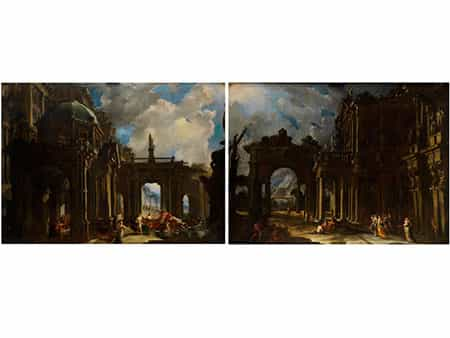Your search for Giovanni Paolo Panini in the auction
16th - 18th century paintings
Thursday, 22 September 2016
» reset
Your personal art agent

You are interested in works by Giovanni Paolo Panini?
We are happy to inform you, if works by Giovanni Paolo Panini are to be auctioned in one of our upcoming auctions.
Please accept our privacy policy
926
Giovanni Paolo Panini,
1691 Piacenza – 1765 Rom
GemäldepaarARCHITEKTONISCHE CAPRICCIOS und SAGEN DER MEDEA Öl auf Leinwand. Doubliert.
Jeweils 168 x 221 cm.
Catalogue price € 150.000 - 200.000
Catalogue price€ 150.000 - 200.000
$ 162,000 - 216,000
£ 135,000 - 180,000
元 1,173,000 - 1,564,000
₽ 14,923,500 - 19,898,000
Beigegeben eine Expertise von Prof. Ferdinando Arisi.
Diese beiden wundervollen monumentalen Cappricci architettonici mit Figuren zeigen im Hintergrund mythologische Szenen, die sich wohl als Darstellungen der zauberkundigen Medea, der Frau des Iason interpretieren lassen. Beide Gemälde zeigen die außerordentliche Begabung und Meisterschaft des jungen Panini, die er bereits um 1715 erlangt hatte. Besonders ersichtlich sind hier sein Einfallsreichtum bei der Gestaltung der äußerst komplexen minuziös dargestellten Architekturen und seine virtuosen Perspektiven. Beide Gemälde gehören sowohl stilistisch als auch chronologisch zu Werken Paninis wie die „Giochi d’acqua” (Wasserspiele; Sammlung Earl of Spencer, Northampton), „Sacrificio di Calliroe” (Opfer der Kallirrhoë; Puskin Museum, Moskau), „Concerto” (Sammlung Seligman) oder „Predica di un Apostolo” (Louvre, Paris). Bei beiden vorliegenden Gemälden finden wir die charakteristischen Stilmerkmale des jungen Panini wieder, die Einflüsse von Giovanni Ghisolfi und Ferdinando Bibiena bis hin zu Alberto Carlieri. Bei den szenenhaften Darstellungen verbindet er geschickt und auf ganz eigenen Weise Vorlagen des Seicento mit dem phantasievoll komplexen Capriccio des Settecento. Man kann sich nur zu gut vorstellen, welche Begeisterung diese Werke in Rom auslösten, als der Maler 1711 in der ewigen Stadt eintraf. Es brachte ihm einen schnellen Aufstieg und 1718 die Aufnahme an der Accademia di San Luca ein. Beide Gemälde besitzen, dank der ausgeprägten Hell-Dunkel-Kontraste, den tiefen Schatten, den dichten Wolken, die den Himmel bedecken, den bedrohlich wirkenden Architekturen und den durch die Ruinen entstehenden lyrischen Akzente eine interessant düstere Stimmung, die Ferdinando Arisi in seiner beilegenden Expertise so treffend als „Piranesi vorwegnehmend” bezeichnet.
Literatur:
Ferdinando Arisi, Panini o Ghisolfi o Carlieri? A proposito dei dipinti giovanili, in: Strenna Piacentina, 2010, S. 92-109, 116-120, fig. 104-105.
Giancarlo Sestieri, Il capriccio architettonico in Italia nel XVII e XVIII secolo, Foligno-Rom 2015, v.I S. 25, fig. 16a-b; v. III, S. 55, fig. 106a-b. (1071901) (21)
Giovanni Paolo Panini,
1691 Piacenza - 1765 Rome
A pair of paintings
ARCHITECTURAL CAPPRICIOS WITH
SCENES FROM THE MYTH OF MEDEA
Oil on canvas.
168 x 221 cm each.
Accompanied by an expert’s report by Professor Ferdinando Arisi.
These two wonderful, monumental capricci architettonici with figures include mythological scenes in the background that are not easily deciphered. The most likely interpretation is that they depict the sorceress Medea, the wife of Jason. Both paintings are excellent examples of the exceptional talent and mastery which the young Panini already possessed ca. 1715. His ingenuity in designing very complex minutely detailed architectural features and his virtuoso perspectives are particularly obvious here.
Both paintings can be attributed to Panini in terms of style and dating and compare well with other works such as Giochi d’acqua [water features] in the collection of Earl Spencer, Northampton; Sacrificio di Calliroe [Sacrifice of Callirhoe] at the State Pushkin Museum, Moscow; Concerto [Concert] in the Seligman collection or Predica di un Apostolo [An Apostle Preaching] in the Louvre, Paris. Both of the offered paintings demonstrate the stylistic features typical of the young Panini’s work, namely the influence of Giovanni Ghisolfi, Ferdinando Bibiena and also Alberto Carlieri. Panini’s scenic depictions combine Seicento models with the imaginative and complex Settecento capriccio in a unique and skilful way. When Panini arrived in the Rome in 1711 it is easy to imagine the excitement his works caused in the eternal city, which ensured his swift rise to fame and earned him admittance into the Accademia di San Luca. Thanks to the pronounced chiaroscuro, the long shadows, dense clouds covering the sky, the menacing architecture and the lyrical accents of the ruins in his compositions, Panini creates an intriguing and sombre atmosphere that Ferdinando Arisi very fittingly describes in his report as “pre-empting Piranesi”.
Literature:
Ferdinando Arisi, 'Panini o Ghisolfi o Carlieri? A proposito dei dipinti giovanili', in Strenna Piacentina, 2010, pp. 92-109, 116-120, fig. 104-105.
Giancarlo Sestieri, Il Capriccio Architettonico in Italia nel XVII e XVIII secolo, Foligno-Rome 2015, v.I, p. 25, fig. 16a-b, v. III, p. 55, fig. 106a-b.
This object has been individually compared to the information in the Art Loss Register data bank and is not registered there as stolen or missing.
Your personal art agent
You would like to be informed of upcoming auctions if a work by Giovanni Paolo Panini is offered? Activate your personal art agent here.
Please accept our privacy policy
You would like to purchase a work by Giovanni Paolo Panini?
Your personal art agent Purchase in Private Sale Calendar
Our experts are happy to support you personally in your search for art objects.
You would like to sell a work by Giovanni Paolo Panini?
Consign now Private Sale Service FAQ
Your consignments are always welcome.
Our staff will be happy to personally assist you every step of the way. We look forward to your call.
Get in touch with our experts
further catalogues Furniture & Interior | Sculpture & Works of art | Silver & Porcelain | Two collections of ivory objects | Boxes & Miniatures | Russian art | 19th century paintings | Modern & Contemporary art | Asian art | Wristwatches & Clocks | Bags & luggage | 16th - 18th century paintings | Jewellery | Hampel Living






























